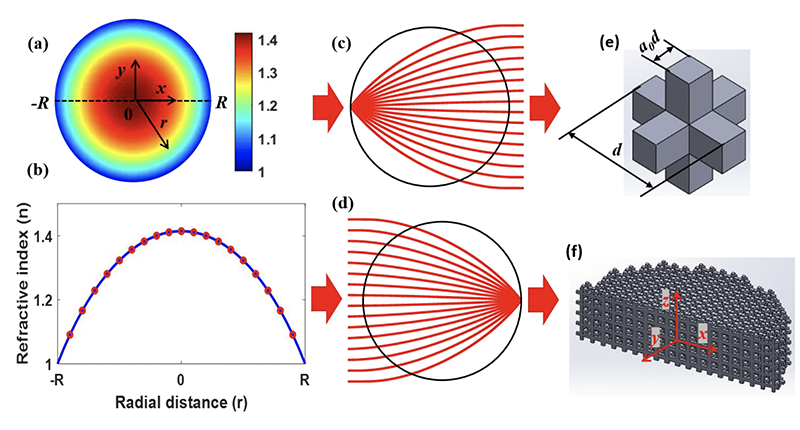 |

|
 |
Figure 2 from the paper: (a) Refractive index distribution of acoustic Luneburg Lens (ALL). (b) Refractive index profile (blue line) along the radial distance (dashed line in (a)), and the red dots indicate the selected refractive indices for the designed ALL. (c) and (d) Ray trajectories for acoustic collimation and focusing based on Luneburg lens. (e) Unit cell used to design ALL. (f) Cross section of 2D circular ALL. |
|
ISR Postdoctoral Researcher Liuxian Zhao, Professor Miao Yu (ME/ISR), and ISR-affiliated Associate Professor Timothy Horiuchi (ECE) are continuing their Luneburg lens research with a new paper, Directional Acoustic Luneburg Lens Waveguide.
Inspired by previous studies of cascaded Luneburg lens for guiding the propagation of optical and structural waves, this paper investigates an acoustic Luneburg Lens (ALL) as a design framework for guiding acoustic wave propagation. The authors develop an acoustic waveguide based on the characteristics of both acoustic wave focusing and collimation of cascaded ALLs. The continuous variation of refractive index of the ALL is achieved by using lattice unit cells with a graded filling ratio. A cascaded ALL waveguide device is fabricated based on the additive manufacturing technique. The experimental results obtained with this device are consistent with the numerical simulations and theoretical calculations.
Similar to optical and structural Luneburg lenses, the ALL has a gradient refractive index profile that increases radially from the outer surface of the lens to its center. The ALL is capable of wave collimation and focusing, and the cascaded ALL waveguide is based on the combination of these two characteristics. When a point source is used for excitation, an ALL can convert the point source into a plane wave. Then the neighboring lens will focus the plane wave perfectly at a point on the other side of the lens. In this way, the source energy can be guided to propagate along the desired direction, which indicates that the cascaded ALLs can serve as a waveguide for acoustic waves.
One potential application of the acoustic Luneburg waveguide is as an on-chip waveguide as part of an acoustic circuit for acoustic communications. At the designed working frequency of 40 kHz, the acoustic Luneburg waveguide can work as a passive acoustic filter while guiding wave propagation along a designed path. At other frequencies, the acoustic wave will diverge. In this case, using an acoustic Luneburg waveguide provides clear advantages, avoiding the use of complex and expensive electronic devices.
The authors analytically, numerically, and experimentally demonstrate for the first time that an acoustic waveguide can be achieved using cascaded ALLs. The ALL used in the waveguide is based on variation of the filling ratio of lattice unit cells, which renders a graded change of refractive index along the radial direction. This ALL allows for both acoustic wave focusing and collimation. By taking advantage of the properties of the ALL, an acoustic waveguide is realized based on cascading four ALLs. This work provides a new solution for the development of acoustic waveguides. It is funded by the Air Force Center of Excellence on Nature-Inspired Flight Technologies and Ideas (NIFTI) and USDA NIFA Sustainable Agricultural Systems.
January 11, 2022
|

